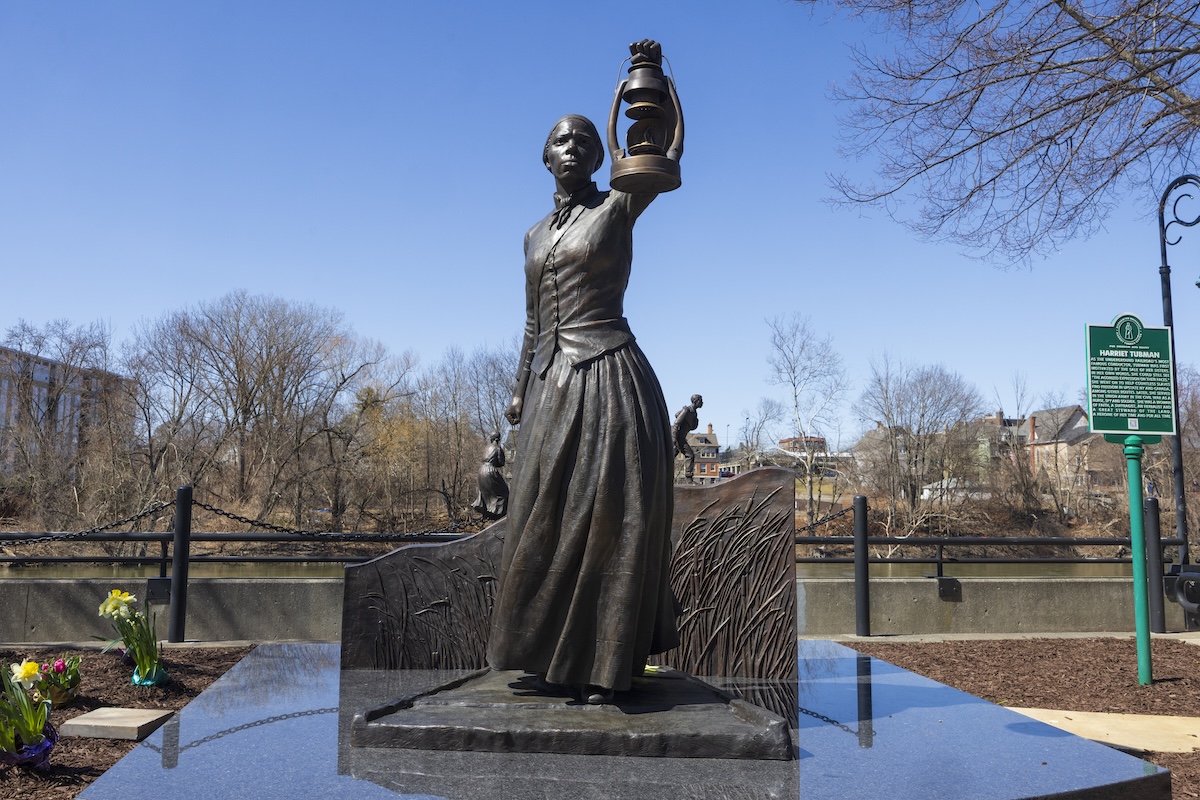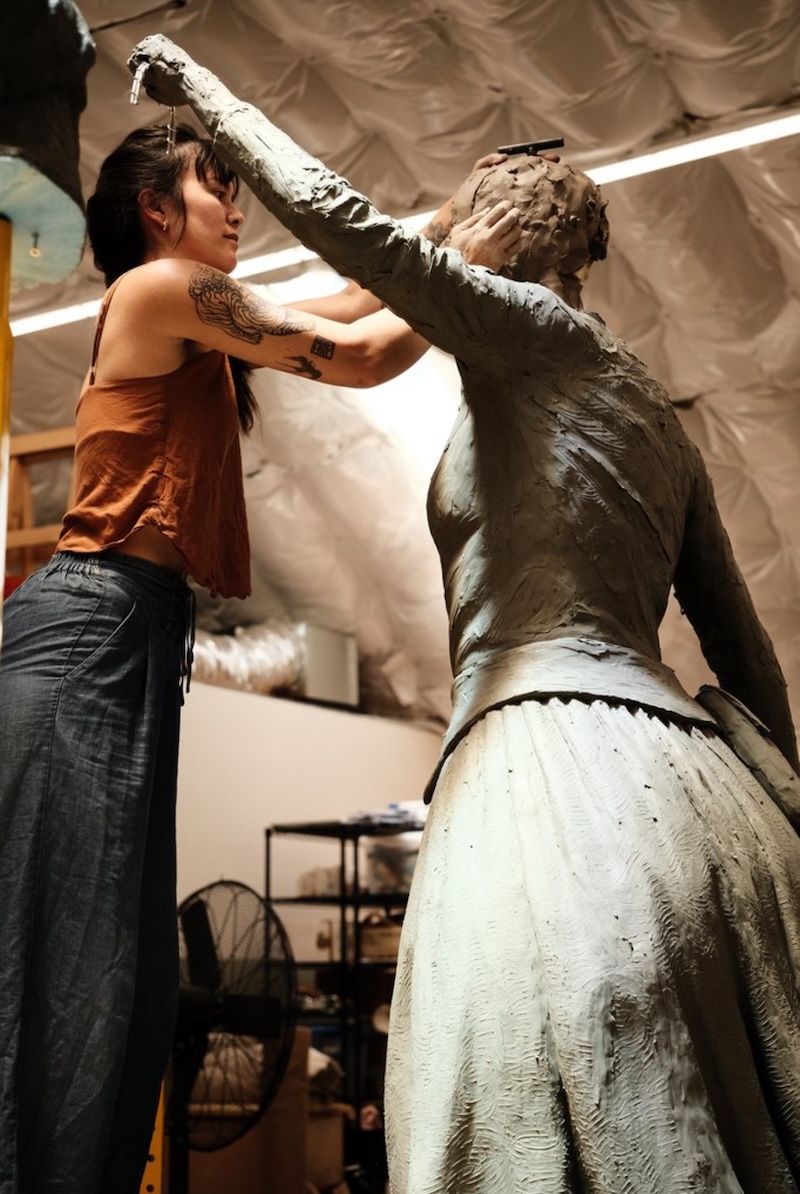Binghamton University unveils statue of abolitionist Harriet Tubman
New sculpture located on Downtown Binghamton Freedom Trail honors the legacy of Underground Railroad conductor

Harriet Tubman, the famous abolitionist and activist who led slaves to freedom along the Underground Railroad, has inspired generations – and she will inspire the Binghamton community thanks to a new statue built in her honor.
The Harriet Tubman Center for Freedom and Equity at Binghamton University unveiled a statue of Tubman during a special event on March 21 at the Binghamton University Downtown Center.
“Our hearts are so full today to see all of our co-creators and collaborators who opened their door and let us in, when we told them about our dream for this day,” said Sharon Bryant, associate director of the Harriet Tubman Center for the Study of Freedom and Equity and associate dean for diversity, equity, and inclusion at the Decker College of Nursing and Health Sciences. “It’s nice to be part of a university and a community that is so open-minded and willing to work together on a common goal.”
The statue is located at Tubman’s marker along the Downtown Binghamton Freedom Trail, a public trail denoting Underground Railroad stops and other anti-slavery and civil rights sites.
The Tubman Center chose to unveil the statue in March as Harriet Tubman Day falls on March 10. Anne Bailey, professor of history and director of the Tubman Center, said that the tour represents the advancement of freedom and equity from Harriet Tubman to Martin Luther King Jr.
“Around the time of the death of George Floyd, there were strong concerns expressed about issues of visibility in the public square,” said Bailey. “Many in our community spoke of learning about Binghamton as a headquarters for the KKK in the 1920s, but did not know that Binghamton N.Y., and Broome County, in general, were a part of the Underground Railroad network, and Harriet Tubman, Gerrit Smith, William Seward and other figures were part of an important hub of anti-slavery activity in Upstate New York.”
The tour ends with the statue of Martin Luther King Jr. on the riverfront, but it is not the end of the journey. “Tubman, King and the other multicultural heroes on the tour are passing the torch to all of us,” Bailey said.
Zoe Dufour, a figurative sculptor, designed the bronze statue. In 2023, Dufour’s design was selected – with feedback from the public – from a short list of five finalists. Dufour said the project was a “dream” for her and is grateful to have been able to bring the sculpture to Binghamton.
“It is an incredible honor to commemorate an individual like Harriet Tubman,” said Dufour. “I want to spend my career sculpting individuals like her, that show us the best parts of humanity. She championed for rights and freedom against what must have felt like unassailable odds and was successful beyond what was imagined possible. She still captivates us today. Her story transcends time and is a reminder to hold hope hand in hand with action, rather than to give into despair.”
The statue depicts Tubman carrying a lantern, meant to symbolize that she knows the way and is illuminating the literal and metaphorical “dark,” said Dufour. The presence of the lantern tells us of the danger she was surrounded by and lights her up as a beacon of hope.
The relief sculpture shown on the wall behind Tubman relates to her skill as an herbalist and naturalist, said Dufour, which was key to her ability to be an Underground Railroad conductor, an army nurse and the first woman to lead a U.S. combat regiment.
“Two years ago, I attended the gallery showing and met many of the talented artists who submitted proposals for this momentous project. It is truly uplifting to see the final statue of a woman who dedicated and risked her life for a better, freer, and more just future for the next generation of Americans,” said SUNY Chancellor John B. King Jr. “Harriet Tubman’s courage, bravery and perseverance in the face of unimaginable cruelty paved the way for institutions like SUNY to provide higher education with the broadest access possible to all New Yorkers. It is our duty to honor her legacy, and this statue stands as a powerful reminder of her unwavering spirit.”
In addition to the Tubman statue and the 13 markers along the trail, the Freedom Trail project includes the development of programming in partnership with local school districts including Binghamton City School District, focused on integrating curricula that includes Black, Indigenous and People of Color (BIPOC) perspectives as well as material that celebrates New York state’s heritage of liberty and civil rights.
“Public art like this can be a powerful force for social equity, diversity and inclusion, in addition to its tremendous contribution to a community’s vibrancy,” said Secretary of State and Chair of the NYS Commission on African American History Walter T. Mosley. “The spirit of Ms. Tubman’s remarkable legacy will now have a permanent presence here in Binghamton, to inspire students, residents and visitors alike to stand up for what’s right, never give up in the face of challenge and make the impossible, possible. Governor Hochul’s unwavering commitment to uplifting and recognizing the contributions of African Americans is what made this project possible, and we thank her for her support.”
The Tubman Center received a $400,000 grant from New York state and an additional $100,000 from the City of Binghamton to support the Freedom Trail project. State Senator Lea Webb and Assemblywoman Donna Lupardo have also been supportive of this project since its inception. The grant was personally arranged by Gov. Kathy Hochul.
“Binghamton’s rich history of the Underground Railroad movement is a profound source of pride for our state,” said Hochul, in a video message. “I hope this new statue and the Freedom Trail project will inspire New Yorkers to keep Harriet Tubman’s legacy alive in our hearts and in our actions. Thank you to Director Ann Bailey, Associate Director Sharon Bryant, and to everyone who made this spectacular day possible. I can’t wait to join you in person and see the statue for myself.”
“With the unveiling of the statue of Harriet Tubman at Binghamton University, we are reminded of the courage and determination that changed the course of history,” said Webb. “Harriet Tubman’s legacy is a beacon of hope, resilience, and the unrelenting pursuit of justice. We not only honor her extraordinary contributions but also renew our commitment to the ongoing fight for equality and freedom for all.”
“I’d like to sincerely thank the Harriett Tubman Center for Freedom and Equity for establishing the Downtown Binghamton Freedom Trail, which now includes a beautiful statue of Harriet Tubman,” said Lupardo. “Artist Zoe Dufour perfectly captured the timeless spirit of Harriet Tubman holding a lantern while leading slaves to freedom. To this day, her lantern serves as a powerful symbol of determination and hope in the face of adversity.”
Bailey, who teaches African American and Caribbean history, said that the trail fits within her academic wheelhouse, but it’s more than that for her – it’s personal. Bailey, an immigrant from Jamaica, said that she owes an incredible debt to Tubman and other heroes on the trail for the sacrifice that made her life possible.
“I would not have the life that I have – my family would not have the life that we have – without their actions. I’m an immigrant from Jamaica. I’m a long-time American citizen, but my family was not here during this period of slavery. They were there in the period of slavery. My family was not here during the civil rights movement. So those who work towards our freedom and equity in the past, those of us here, all of us here, are literally standing on their shoulders.”


